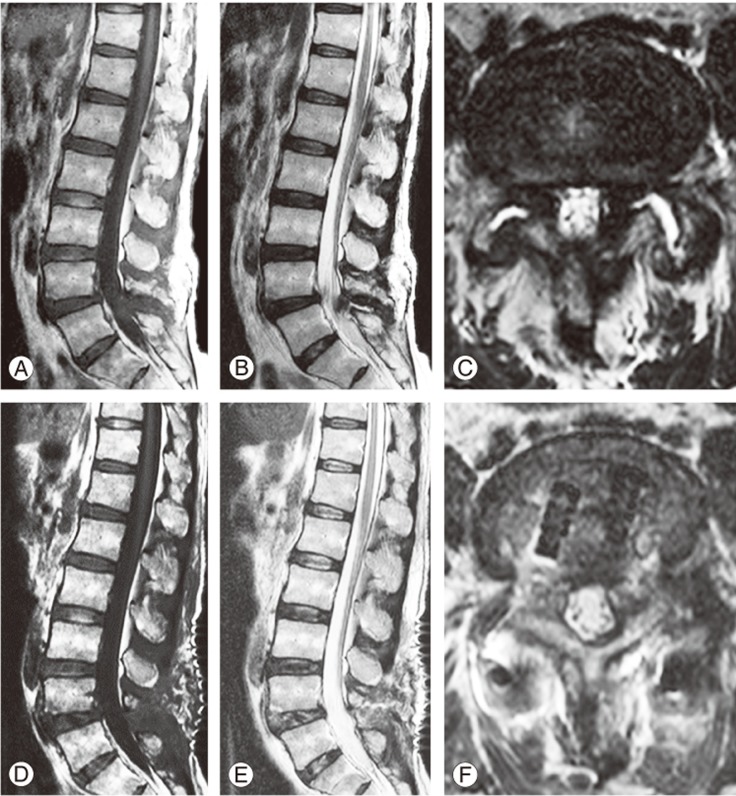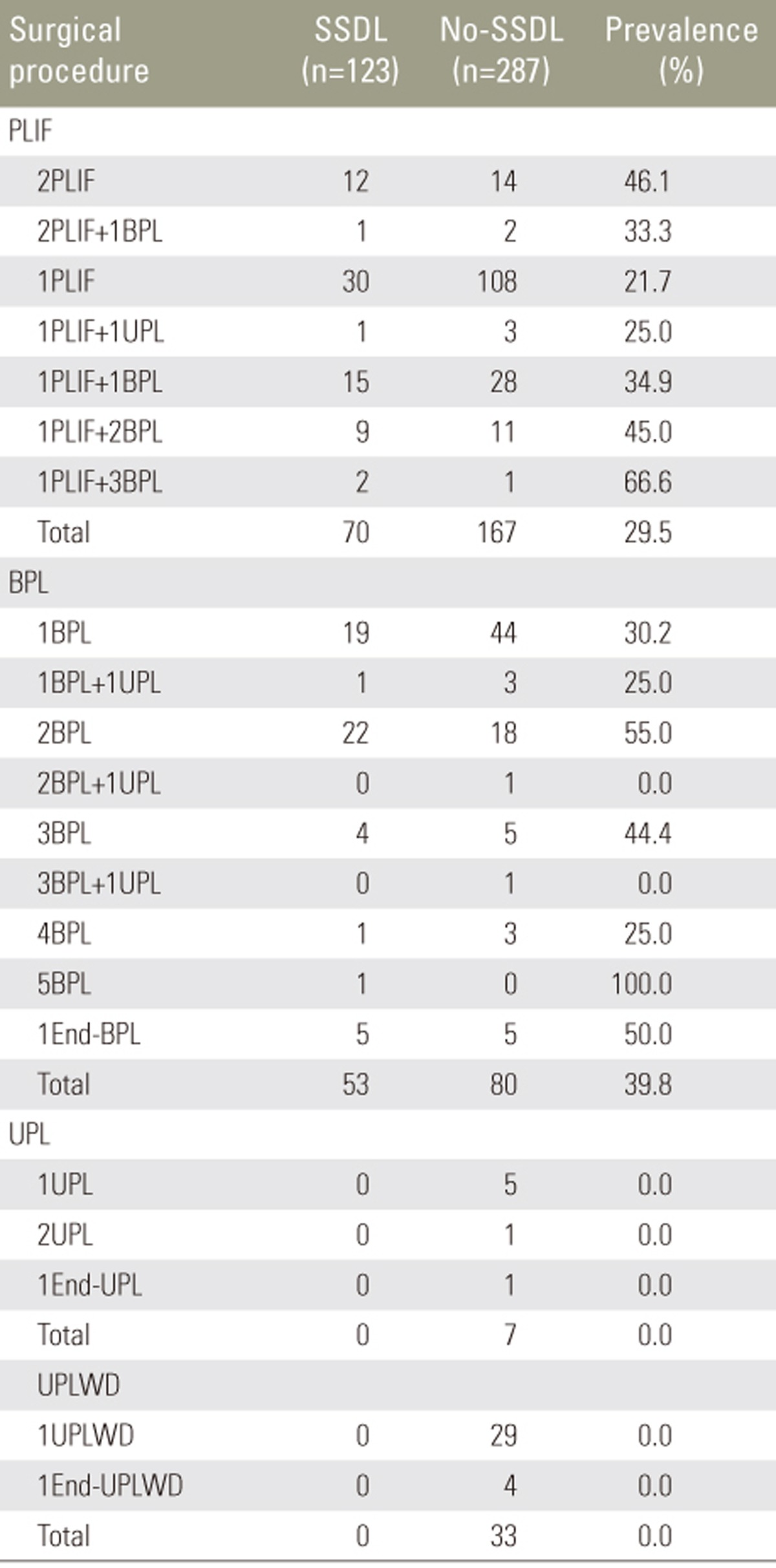 |
 |
- Search
| Asian Spine J > Volume 11(5); 2017 > Article |
|
Abstract
Purpose
Overview of Literature
Methods
Results
Acknowledgments
Notes
Conflict of Interest: No potential conflict of interest relevant to this article was reported.
References
Fig.┬Ā1
Magnetic resonance imaging (MRI)-based grading system for the diagnosis of spinal subdural lesions (SSDLs) based on preoperative to postoperative changes within the dura mater. The three SSDL grades are depicted.

Fig.┬Ā2
An illustrative case of ŌĆ£grade 0ŌĆØ spinal subdural lesion (SSDL) according to our grading system. There was no evidence of postoperative changes in the dura mater on T2-weighted sagittal or axial magnetic resonance (MR) images. (A) preoperative T1-weighted sagittal MR image, (B) preoperative T2-weighted sagittal MR image, (C) preoperative T2-weighted axial MR image, (D) postoperative T1-weighted sagittal MR image, (E) postoperative T2-weighted sagittal MR image, and (F) postoperative T2-weighted axial MR image.

Fig.┬Ā3
An illustrative case of ŌĆ£grade 1ŌĆØ spinal subdural lesion (SSDL) according to our grading system. Space-occupying lesion (SOL) was identified within the dura mater. The signal intensity of SOL was equivalent to that of cerebrospinal fluid (T1 hypo-intensity/T2 hyper-intensity). These SOLs are considered arachnoid cysts. (A). preoperative T1-weighted sagittal magnetic resonance (MR) image, (B) preoperative T2-weighted sagittal MR image, (C) preoperative T2-weighted axial MR image, (D) postoperative T1-weighted sagittal MR image, (E) postoperative T2-weighted sagittal MR image, (F) postoperative T2-weighted axial MR image, (G) magnified postoperative T1-weighted sagittal MR image, and (H) magnified postoperative T2-weighted sagittal MR image. Arrows indicate fluid collection within the dura mater.

Fig.┬Ā4
An illustrative case of ŌĆ£grade 2ŌĆØ spinal subdural lesion (SSDL) according to our grading system. Space-occupying lesion (SOL) was identified within the dura mater. The signal intensity of SOL was different from that of cerebrospinal fluid. These SOLs are more likely to be spinal subdural hematomas than arachnoid cysts. (A) Preoperative T1-weighted sagittal magnetic resonance (MR) image, (B) preoperative T2-weighted sagittal MR image, (C) preoperative T2-weighted axial MR image, (D) postoperative T1-weighted sagittal MR image, (E) postoperative T2-weighted sagittal MR image, (F) postoperative T2-weighted axial MR image, (G) magnified postoperative T1-weighted sagittal MR image, and (H) magnified postoperative T2-weighted sagittal MR image. Arrows indicate fluid collection within the dura mater.

Fig.┬Ā5
(A) Magnetic resonance image taken on postoperative day 4, with the T1-weighted sagittal image showing a large hypointense posterior collection within the dural sac from approximately T10 to S1. (B) T2-weighted sagittal image showing hyper-intensity within the same collection. (C) T2-weighted axial image taken at the L2ŌĆōL3 level showing anterior displacement and compression of the cauda equina.

Fig.┬Ā6
(A) Intraoperative photograph showing an extensive mass of clotted blood that was identified when the dura mater was opened. (B, C) Following en bloc evacuation of the clotted blood, the distended normal arachnoid sac was exposed. (D) Fenestration of the arachnoid membrane was performed.

Fig.┬Ā7
Magnetic resonance (MR) image obtained on postoperative day 2 following revision surgery. (A, B) T1-and T2-weighted sagittal MR images showing a decrease in the volume of the posterior compartment. (C) T2-weighted axial MR image taken at the L2ŌĆōL3 level confirming the decompression of the cauda equina.

Table┬Ā3
Comparison of patients with and without postoperative SSDL

Values are presented as mean┬▒standard deviation (SD) or number (%).
Fisher exact test or Mann-Whitney U test was used to compare each factor between patients with and without postoperative SSDL.
SSDL, spinal subdural lesion; M, male; F, female; PLIF, posterior lumbar interbody fusion; BPL, bilateral partial laminectomy; UPL, unilateral partial laminectomy.
*p<0.05.
Table┬Ā4
Logistic regression analysis of risk factors of postoperative SSDL

The multivariate model included variables with a p-value <0.05 on univariate analysis. The multivariate model was adjusted for age, BPL, UPL, discectomy reoperation at the same level, and length of surgical level.
SSDL, spinal subdural lesion; BPL, bilateral partial laminectomy; UPL, unilateral partial laminectomy.
*p<0.05.
- TOOLS
-
METRICS

- Related articles in ASJ
-
Epidural Fibrosis after Lumbar Disc Surgery: Prevention and Outcome Evaluation2015 June;9(3)








